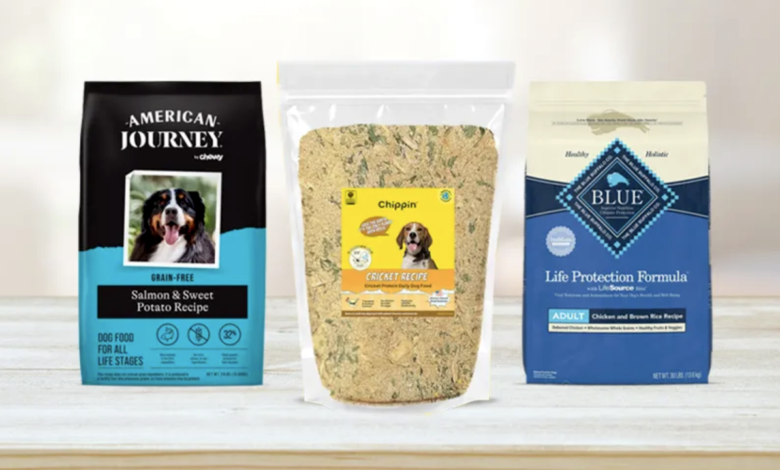
The Best Dry Dog Foods 2024
Choosing the right food for your furry friend is not just about filling their bowl; it’s a decision that directly impacts their health and happiness. In this comprehensive guide, we’ll navigate the world of dry dog foods, shedding light on what makes them a popular choice among pet owners. From nutritional considerations to the top brands in 2024, we’ve got you covered.
Read More: 15 Top USA Pet Food Brands in 2024
The Best Dry Dog Foods 2024

Why Your Dog’s Diet Matters
Your dog’s diet isn’t just about sustaining them; it’s a fundamental aspect of their overall well-being. The food you choose has a profound impact on their energy levels, coat health, and even their lifespan. As responsible pet owners, understanding the significance of a well-balanced diet is the first step in ensuring your furry companion lives a healthy and happy life.
The Nutritional Impact
Nutrition is the cornerstone of a healthy life, and this holds for our four-legged friends. Dogs, like humans, require a balanced and nutritious diet to thrive. The choices you make regarding their food directly affect their vitality, immune system, and overall quality of life. As we delve into the world of dry dog foods, it’s crucial to grasp the importance of providing optimal nutrition for your canine companion.
Understanding Dry Dog Foods
What Sets Dry Dog Food Apart?
Dry dog food, often referred to as kibble, stands out as a popular choice among pet owners for several reasons. Its convenience, longer shelf life, and dental benefits make it a preferred option for those seeking a practical and nutritionally sound solution for their pets. Let’s explore what distinguishes dry dog food from other options in the market.
Benefits Beyond Convenience
While the convenience of dry dog food is undeniable, it offers additional benefits that contribute to your dog’s overall health. The crunchiness of kibble helps reduce plaque and tartar buildup, promoting dental health. However, with the myriad of options available, what factors should you consider when making a choice?
Factors to Consider When Choosing Dry Dog Food
Nutritional Content Matters
Not all dry dog foods are created equal when it comes to nutritional content. The key is to look for options with high-quality protein sources, essential vitamins, and minerals. Understanding your dog’s specific nutritional needs is paramount in making the right choice for their overall well-being.
Ingredient Quality
The quality of ingredients plays a crucial role in determining the nutritional value of dry dog food. Opt for options that list real meat as the primary ingredient and avoid those with excessive fillers. Quality ingredients contribute to a healthier coat, better digestion, and an overall thriving pet.
Breed-Specific Considerations
Different dog breeds have varying nutritional requirements. It’s essential to consider your dog’s breed and size when selecting dry dog food. Some brands offer formulas specifically tailored to certain breeds, ensuring your furry friend gets the precise nutrients they need.
Budget-Friendly Options
While quality is of the essence, budget considerations are also a reality for many pet owners. The good news is that there are affordable dry dog food options that meet high standards. Striking a balance between quality and cost ensures that your dog receives optimal nutrition without putting a strain on your wallet.
Top 5 Dry Dog Foods in 2024
Brand 1: Nutrient-Rich and Popular Among Dogs
Brand 1 stands out for its nutrient-rich formula that not only satisfies the taste buds of even the pickiest eaters but also positively impacts energy levels and coat health. Real user reviews consistently praise its effectiveness in promoting overall well-being.
Brand 2: Specially Formulated for Specific Dietary Needs
For dogs with specific dietary needs, Brand 2 takes the spotlight. Whether your dog has allergies or sensitivities, this brand offers specialized formulas that cater to individual requirements. It’s a testament to the evolving nature of the pet food industry, recognizing and addressing the diverse needs of our canine companions.
Brand 3: Affordable Yet High-Quality Option
Brand 3 proves that providing high-quality nutrition for your dog doesn’t have to break the bank. With a perfect balance between cost and quality, it emerges as an excellent choice for pet owners looking for affordability without compromising on the nutritional front.
Brand 4: Ideal for Sensitive Stomachs
If your dog has a sensitive stomach, Brand 4 is worth considering. Its gentle formula eases digestion, making mealtime a comfortable experience for dogs prone to stomach sensitivities. The emphasis on digestive health reflects a growing awareness of individualized pet nutrition.
Brand 5: Grain-Free and Suitable for Various Breeds
For dogs with grain sensitivities or those following a grain-free diet, Brand 5 emerges as a delicious solution. Suitable for various breeds, it provides a well-rounded, grain-free diet for dogs with specific dietary requirements. The variety of options available reflects the industry’s commitment to catering to diverse canine needs.
How to Transition Your Dog to a New Dry Food
Gradual Introduction Process
When transitioning to a new dry dog food, a gradual approach is key. Abrupt changes can lead to digestive upset, so it’s advisable to mix the new food with the old one, gradually increasing the ratio over several days. This minimizes the chances of discomfort and allows your dog to adjust seamlessly.
Monitoring Your Dog’s Response
During the transition period, closely monitor your dog for any signs of discomfort, allergies, or digestive issues. If you notice adverse reactions, consult your veterinarian for guidance on alternative options. A personalized approach ensures a smooth transition and optimal health for your furry friend.
Common Misconceptions About Dry Dog Food
Myth 1: Dry Dog Food Lacks Nutritional Value
One common misconception is that dry dog food lacks nutritional value. In reality, high-quality dry dog foods are formulated to meet dogs’ nutritional needs, providing a convenient and nutritious option for pet owners. The key is to choose reputable brands that prioritize quality ingredients.
Myth 2: All Dry Dog Foods Are the Same
Not all dry dog foods are created equal. They vary in nutritional content, ingredient quality, and formula. It’s crucial to recognize that different brands offer unique formulations, catering to diverse canine needs. Understanding these differences allows you to make an informed decision for your pet.
Myth 3: Grain-Free Diets Are Necessary for All Dogs
While some dogs benefit from grain-free diets, it’s not a universal requirement. Grain-free options are suitable for dogs with sensitivities, but it’s essential to assess your dog’s individual needs before making dietary changes. Choosing the right type of dry dog food requires a nuanced understanding of your dog’s health and preferences.
Ensuring Your Dog’s Hydration While on Dry Food
Importance of Water Intake for Dogs
Dry dog food, despite its many benefits, doesn’t replace the need for water. Adequate hydration is vital for your dog’s overall health. Always provide fresh water alongside dry food to ensure your pet stays well-hydrated. This simple practice contributes to their overall well-being.
Tips for Encouraging Hydration
To encourage hydration, consider wetting the dry dog food with water or adding broth. This not only enhances the flavor but also increases moisture intake. Experiment with different methods to find what works best for your dog. A well-hydrated pet is a healthy pet.
Tailoring Dry Dog Food Choices to Your Dog’s Needs
Puppy-Specific Dry Foods
Puppies have unique nutritional requirements for growth and development. Choosing dry dog foods specifically formulated for puppies ensures they receive the essential nutrients for a healthy start in life. The importance of tailored nutrition during the puppy stage cannot be overstated.
Senior Dog Considerations
As dogs age, their nutritional needs change. Opting for dry dog foods tailored to senior dogs addresses specific issues such as joint health and maintaining an ideal weight. Recognizing and addressing these needs contributes to a fulfilling and comfortable life for your aging companion.
Specialized Diets for Health Conditions
If your dog has specific health conditions, consulting your vet for recommendations on specialized diets is crucial. Some dry dog foods are formulated to address issues like allergies, joint problems, or weight management. Tailoring their diet to their health requirements is a proactive step towards maintaining their well-being.
Addressing Allergies and Sensitivities with Dry Dog Food
Identifying Allergic Reactions
It’s essential to watch for signs of allergies, such as itching, digestive issues, or changes in behavior. If you suspect allergies, consult your vet for guidance. Switching to hypoallergenic dry dog food may be recommended to minimize allergens and ensure your dog thrives without discomfort.
Choosing Hypoallergenic Options
Hypoallergenic dry dog foods are specifically formulated to minimize potential allergens. These options are ideal for dogs with sensitivities, providing a gentle and easily digestible alternative. Understanding your dog’s specific needs and choosing accordingly contributes to their overall health and happiness.
Homemade vs. Commercial Dry Dog Food
Pros and Cons of Homemade Dog Food
While some pet owners prefer homemade dog food for complete control over ingredients, it’s essential to balance the diet correctly. Homemade diets may lack certain nutrients, making commercial dry dog food a more reliable option for comprehensive nutrition. Benefits of Reputable Commercial Brands
Reputable commercial brands undergo rigorous testing to ensure their products meet high-quality standards. They provide a convenient and nutritionally balanced option, saving time and effort while ensuring your dog gets the necessary nutrients. Opting for well-established brands with a proven track record is a reliable approach to meeting your dog’s nutritional needs.
Reading and Understanding Dog Food Labels
Key Ingredients to Look For
When reading dog food labels, prioritize high-quality ingredients such as real meat, whole grains, and vegetables. Avoid options with excessive additives, fillers, and artificial preservatives. Understanding labels empowers you to make informed choices, ensuring your dog receives nutrition from wholesome sources.
Warning Signs on Labels
Be wary of vague terms like “meat by-products” or excessive use of fillers on dog food labels. These may indicate lower-quality options. Choose brands that transparently list their ingredients, allowing you to make the best choice for your dog’s health. Reading and understanding labels is a critical skill in selecting the right dry dog food.
Storing Dry Dog Food Properly
Importance of Proper Storage
Proper storage is paramount to maintaining the freshness and nutritional value of dry dog food. Store it in a cool, dry place, away from direct sunlight. Additionally, seal the bag tightly after each use to prevent exposure to moisture and air, ensuring the food remains fresh and palatable.
Tips for Maintaining Freshness
Consider transferring dry dog food to an airtight container for added freshness. Monitor the expiration date, and discard any expired or stale food. Fresh, high-quality food ensures your dog receives optimal nutrition, contributing to their overall health and happiness.
Real User Reviews and Experiences

Gathering Insights from Dog Owners
Real user reviews provide valuable insights into the effectiveness and palatability of different dry dog food brands. Explore online platforms and communities where dog owners share their experiences to make an informed decision. Learning from the firsthand experiences of other pet owners adds a practical dimension to your decision-making process.
Online Platforms for Reliable Reviews
When seeking reviews, focus on reputable websites, forums, and social media groups dedicated to pet care. Pay attention to reviews from dog owners with similar breeds or health concerns, as their experiences can guide you in selecting the right dry dog food. A collective understanding from a community of pet owners enhances the reliability of the information gathered.
The Final Words
Choosing the best dry dog food involves careful consideration of factors such as nutritional content, ingredient quality, and your dog’s individual needs. The top brands in 2024 offer a diverse range of options, catering to different preferences and dietary requirements. Remember to transition your dog gradually, monitor their response, and consult your vet for personalized advice. Providing your furry companion with the right dry dog food contributes to their overall health, happiness, and longevity.
Read More: Why is My Dog Constipated & What to Do?
FAQs
- How Much Dry Food Should I Feed My Dog? Determining the right amount of dry food depends on your dog’s size, age, and activity level. Follow the guidelines provided by the brand, and adjust based on your dog’s individual needs. Regularly assess their weight and condition to ensure you’re providing an appropriate amount.
- Can I Mix Different Brands of Dry Dog Food? While it’s generally advisable to stick to one brand, some dogs tolerate a mix of brands well. Monitor your dog for any adverse reactions, such as digestive upset or allergies, and consult your vet if unsure. Gradual transitions help in identifying compatibility.
- Are Organic Dry Dog Foods Worth the Investment? The value of organic dry dog foods depends on your priorities and budget. Assess the ingredients and certifications to determine if the additional cost aligns with your preferences for your dog’s nutrition. While organic options may offer certain benefits, it’s essential to weigh them against your individual considerations.
- Should I Consult My Vet Before Changing My Dog’s Diet? Yes, consulting your vet before making any dietary changes is highly recommended. Vets provide personalized advice based on your dog’s health, ensuring a smooth transition and optimal nutrition. They can also identify any specific dietary requirements based on your dog’s breed, age, and health conditions.
- What Should I Do If My Dog Refuses to Eat Dry Food? If your dog refuses dry food, consider gradually mixing it with wet food or adding a tasty topper to enhance palatability. Monitor their response, and if the issue persists, consult your vet to rule out any underlying health concerns that may be affecting their appetite. A proactive approach ensures your dog maintains a healthy appetite.








One Comment